How To Get The Most Out Of Multi-Winner RCV
A Policy Guide
This report was a collaboration between RepresentUs and FairVote.
Introduction
Ranked choice voting (RCV) makes elections more fair. It can be used in elections with a single winner, like mayor or governor; and elections with multiple winners, like city council or school board. When adopting RCV for multi-winner elections, there are simple ways to ensure you’re maximizing its benefits and avoiding common pitfalls. This policy guide presents recommendations to ensure you’re getting the most out of multi-winner RCV.
Use proportional RCV for multi-winner elections
Proportional RCV, known internationally as the single transferable vote, is the best method for applying RCV to multiwinner elections. It elects winners proportionally, meaning that each group of voters can expect to win seats roughly in proportion to their share of the electorate. For example, a group that makes up 30% of a city should win about 30% of seats.
Like single-winner RCV, proportional RCV elects candidates who earn a certain share of votes. Under single-winner RCV, that share is more than half (50%). Under proportional RCV, the share depends on the number of people being elected. When electing two people, a candidate needs to win more than a third (33%) of the vote. When electing three people, the amount is more than a quarter (25%), and so on.
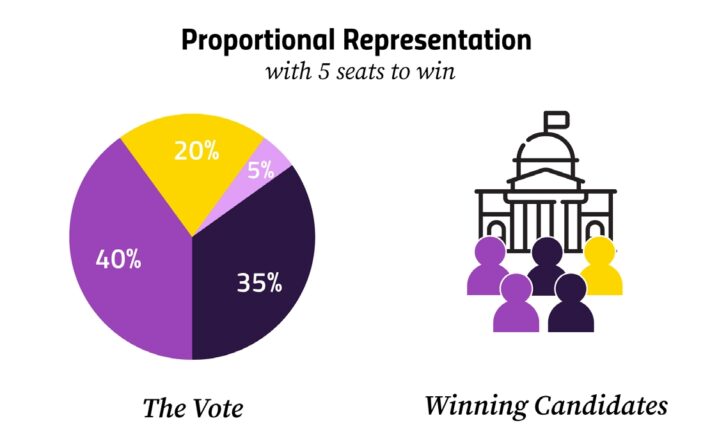
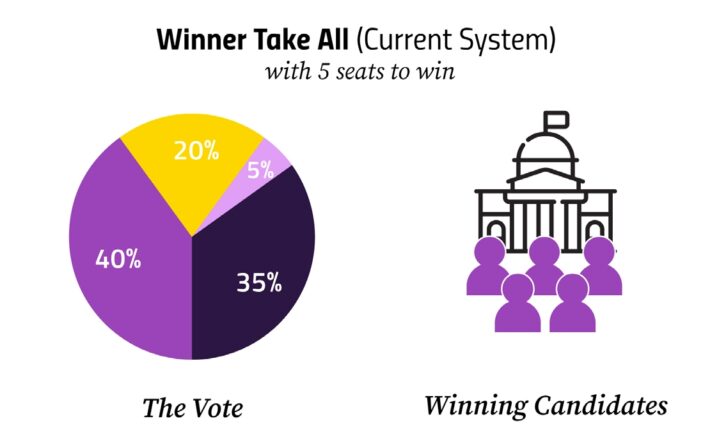
This differs from most other forms of multi-winner elections currently used in the U.S. because most other election methods are “winner-take-all,” meaning the largest group of voters can control 100% of seats and shut out other voices. Proportional RCV solves this problem. It preserves majority rule, but also awards a fair number of seats to minority communities.
Some examples of cities using proportional RCV for multi-winner offices include Cambridge, MA; Portland, ME; and Minneapolis, MN. Additionally, Portland, OR recently adopted the method, and will use it for the first time in November 2024.
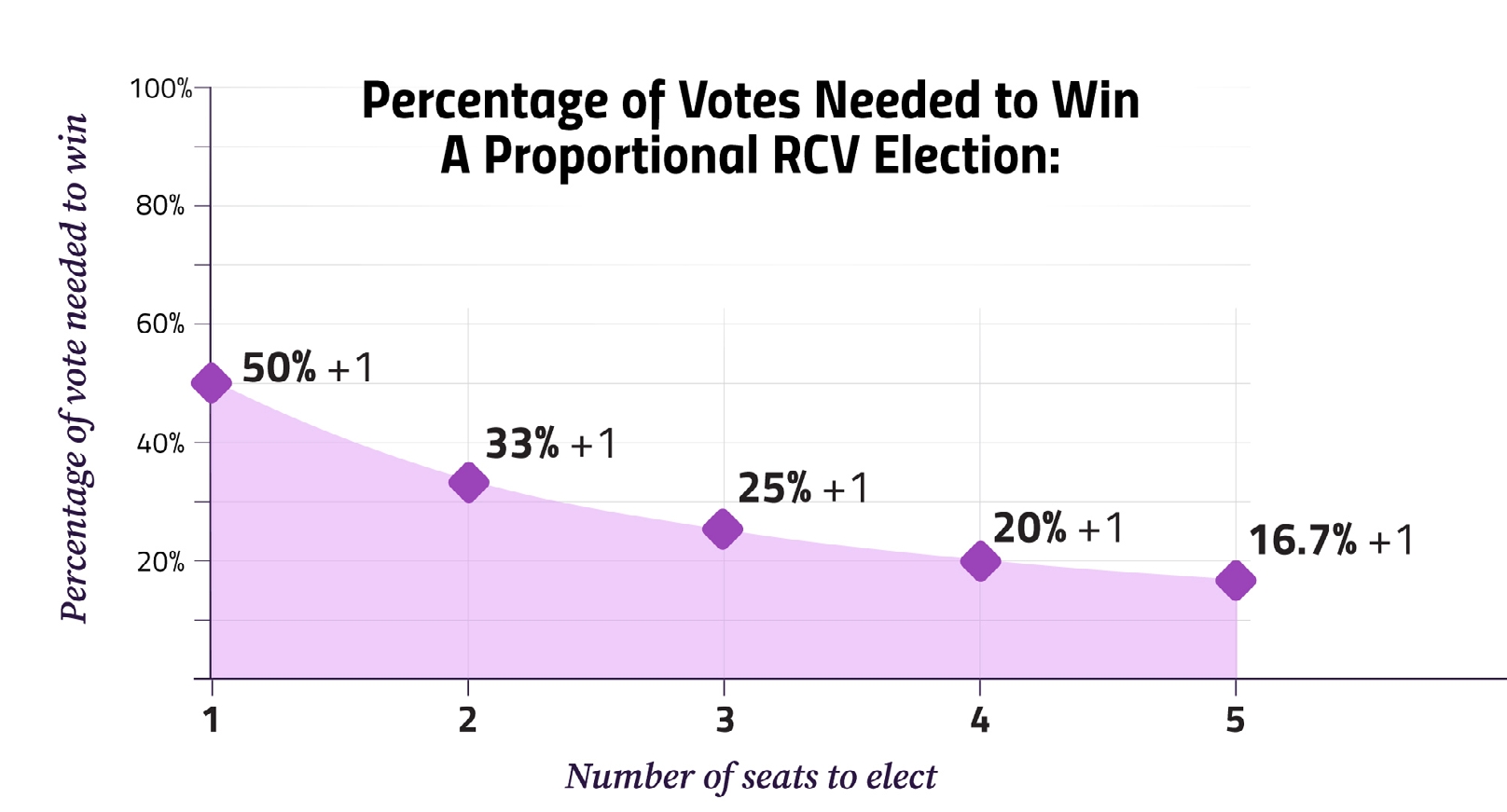
There are other forms of multi-winner RCV, but they are either winner-take-all or only can’t guarantee proportional outcomes. The best way to ensure each group is represented fairly is to use proportional RCV.
The voter experience is the same with proportional RCV as with other types of RCV. Voters will still rank candidates in order of preference, and the ballot design is the same.
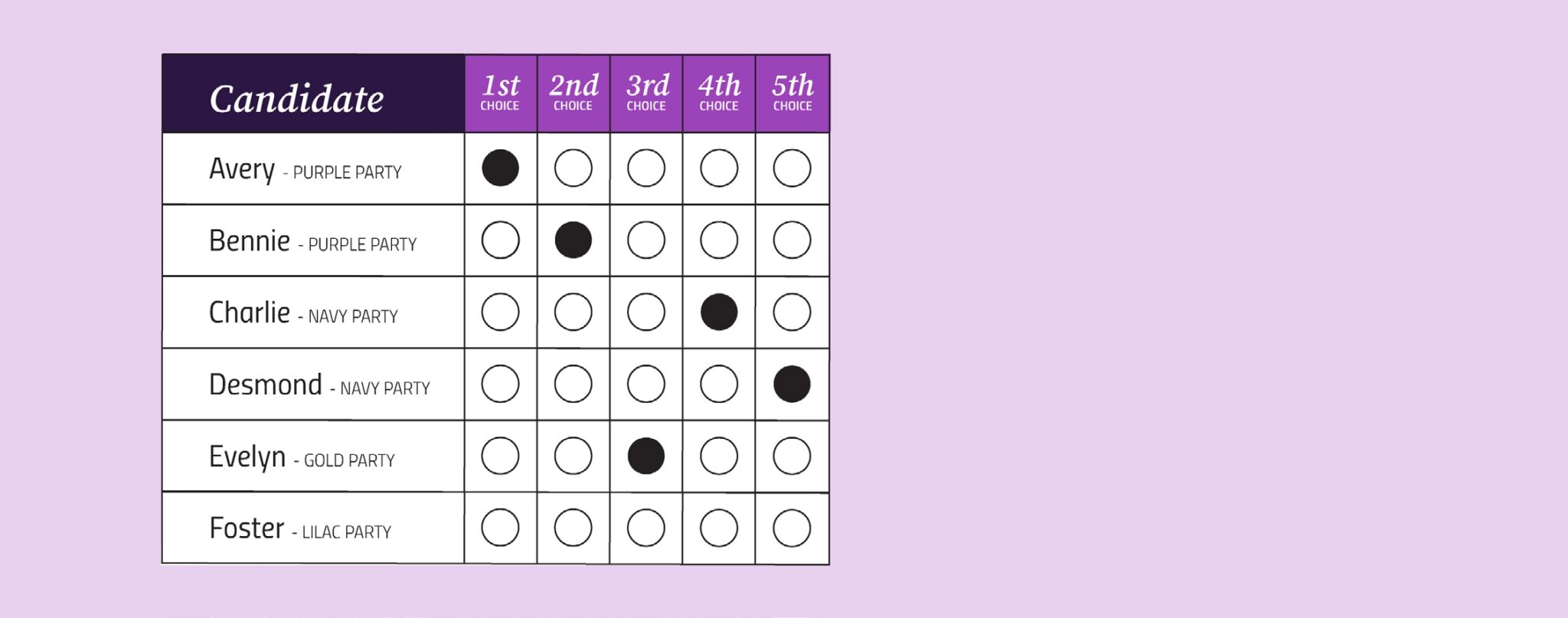
Further reading:
- Proportional Representation, Explained, RepresentUs
- How proportional representation works, FairVote
- Types of RCV for multi-seat bodies, FairVote
- Proportional RCV FAQ, FairVote
- Where is proportional RCV used? FairVote
Elect between three and five seats at a time
The more seats you elect at a time, the closer you can get to true proportionality and fair representation. However, electing too many seats at once also comes with trade-offs in terms of ballot design, because it might mean many candidates and long ballots.
The sweet spot for maximizing proportionality and voter choice while minimizing complexity is to elect three to five seats at a time, but some cities may choose to elect more seats at a time and still gain the benefits of proportional RCV, like Cambridge, MA.
Considerations:
- Proportionality: A three-seat election requires a candidate to win more than a quarter of the vote, meaning that a group needs to make up about 25% of the electorate to win representation. A six-seat election requires a candidate to win more than a seventh of the vote, so a group only needs a little over 14% of the electorate to elect its preferred candidate. A community that is 20% of the electorate may not be able to win representation in a three-seat election, but would be able to do so in a five- or six-seat election. Electing more candidates will lead to more proportional outcomes that more closely reflect the will of the voters.
More Seats, More Proportional Representation
Threshold for victory lowers with additional winners
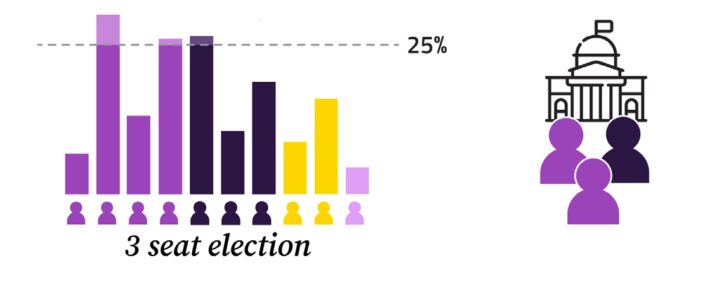

- Ballot size: Races that elect more people typically attract more candidates, taking up more room on a ballot. Ballot length can affect voter experience and election administration. Longer ballots can overwhelm and confuse voters, which can cause voters to make mistakes when filling them out or to leave parts of the ballot incomplete. Research has found that regardless of election method, elections with more candidates have a higher rate of ballot error, even when the ballots limit the number of rankings. Races that take up a lot of room can also create challenges for election
administrators when designing ballots, and longer ballots can lead to increased printing costs. - Single-round vs. multi-round elections: Consider eliminating primary or runoff elections if your city currently has them. RCV can serve a similar function to two-round elections, without asking voters to go to the polls twice. Consolidating primaries or runoffs into a single election can save money on election administration and campaigning, and ensures the winner is chosen on a single general election day – when turnout is naturally the highest.
Example 1: A small council should elect all seats at once
A city with a four-member city council falls perfectly within this range if voters elect all four seats at once. However, some cities choose to stagger their city council terms, with two members being elected in each election cycle. A two-winner election is unlikely to be proportional because the number of winners is too low to accurately represent different factions. In this case, we recommend un-staggering the elections so all four members are elected at once.
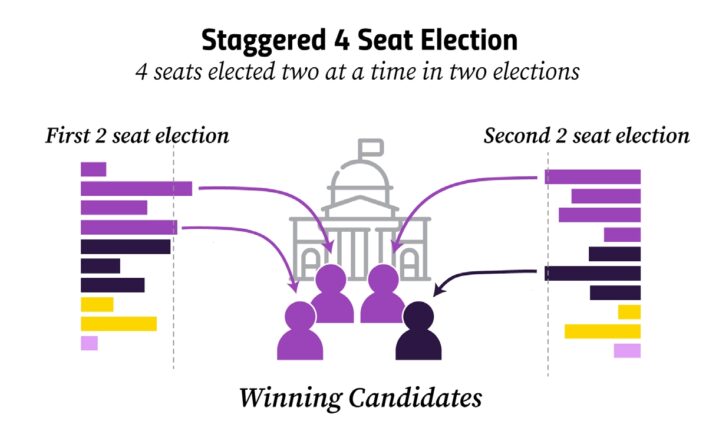
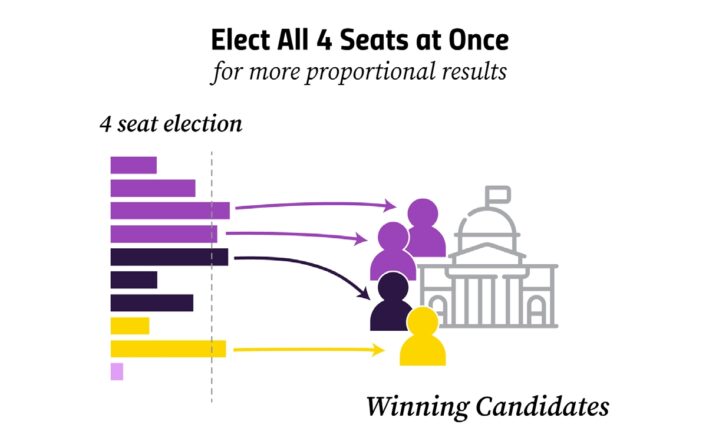
Example 2: A large council needs multi-member districts
A city with a fifteen-member council has too many members to elect them all citywide at the same time. In order to meet the recommendation of electing three to five seats at a time, we recommend dividing the city into districts. Having three districts that elect five councilors each is a good way to achieve proportionality and promote local representation.
Further reading:
Applying these lessons to voting rights acts:
The federal Voting Rights Act and several state voting rights acts allow proportional RCV as a remedy when winner-take-all voting dilutes the votes of a protected class.
If you are involved in a voting rights lawsuit and interested in using proportional RCV as a remedy, it is important to use districts with enough representatives to have thresholds of election below the expected voter turnout of the community seeking representation. For example, if turnout estimates project the community to be about 20% of voters in a typical election, then a three-member district (which has a threshold of 25%) will be too small. A four-member district (threshold of 20%) is better but still risky due to fluctuations in turnout over time. A fiveor six-member district (thresholds of 16.7% and 14.3%, respectively) would ensure the impacted community can almost always elect at least one candidate of its choice.
Consider the total size of the council or board
While city council size is a separate issue from the voting method used, reforms to both are sometimes pursued simultaneously. Both issues affect whether a government is properly serving its constituents.
Council sizes vary widely across cities and towns in the U.S. In some cities, councilors represent hundreds of thousands of constituents. In others, they represent only a few hundred constituents.
While some reformers may be skeptical of increasing the number of elected officials, larger elected bodies can benefit voters. More council members means more opportunities to elect candidates with different backgrounds, experiences, and perspectives. Lowering the ratio of constituents to elected officials means that members’ offices can spend more time and resources on each constituent with a problem. As fewer voters are needed to elect a candidate, each individual vote becomes more important.
The benefits of a larger council are even more powerful when combined with a proportional election method, like proportional RCV.
Further reading:
- Multi-seat Districts and Larger Assemblies Produce More Diverse Racial Representation, Michael Latner, Jack Santucci, and Matthew Shugart
- Portland (OR) Charter Commission June 2022 report
- New Government for Today’s Portland: Rethinking the Commission System & How We Vote, City Club of Portland (OR)
Applying these lessons to voting rights acts:
If you are creating a state voting rights act, consider explicitly granting courts authority to expand the size of elected bodies to allow for greater proportionality when crafting a remedy
Allow candidates to form “slates” in nonpartisan elections
A candidate slate is a group of candidates who have common policy goals and choose to align with each other during a campaign. For example, candidates may join a “clean energy slate” or a “business development slate” to ally with likeminded candidates and ask voters to rank them all. Slates can be formed by candidates themselves, or they can come in the form of endorsements from parties or community organizations.
Multi-winner elections tend to draw large fields of candidates, so slates can help voters understand the candidates’ positions and make informed choices. This is particularly true in municipal races that lack party labels, because research shows that party labels are typically the most useful information to voters.
In nonpartisan races, we recommend adopting ballot design rules that allow candidates to display their slate identifications on the ballot, where the law allows, similar to how candidates can identify as a party nominee in partisan races. For example, Minneapolis, MN allows a candidate to include up to three words under their name on the ballot that expresses the candidate’s “political party or principle.” Providing a similar option could allow candidates to signal that they are running on the same slate and give voters more information about what they stand for.
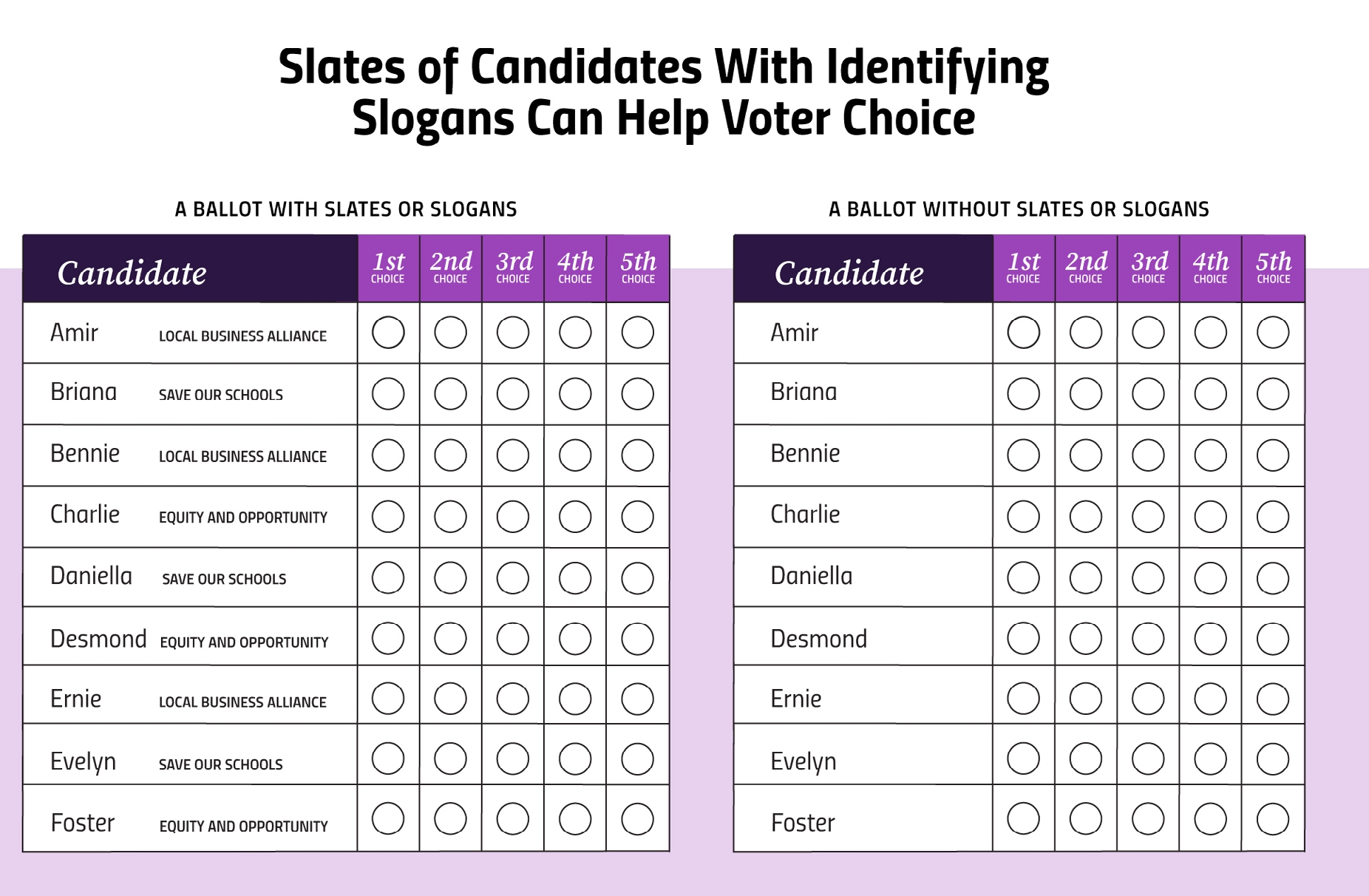
Further reading:
- Sample RCV ballot from Minneapolis with candidates’ self identifications
- How candidate slates impact voter behavior in Cambridge, MA, FairVote
- Political science research on the importance of party labels and other indicators on the ballot:
- Teams without Uniforms: The Nonpartisan Ballot in State and Local Elections, Brian F. Schaffner, Matthew Streb, and Gerald Wright
- How Partisan Identification on the Ballot Affects Individuals’ Vote Choices, Jennica Petersen and Rebecca Shuel
- The Partisan Heuristic in Low-Information Elections, Brian Schaffner and Matthew Streb
- Party Labels and Vote Choice in Judicial Elections, Craig Burnett and Lydia Tiede
Case study: Portland Charter Review Commission
Summary
The Charter Review Commission in Portland, Oregon grappled with many of the above policy questions in its June 2022 Final Report. Many of the Commission’s recommendations were aligned with our suggestions in this report. Below, we review a few of the Commission’s recommendations related to multi-winner RCV, and the rationale for their choices as cited in the report:
- Increasing the size of the city council from four to 12 members, and electing half of the seats every two years
- Rationale:
- Commenters recommended increasing the size of the city council to increase representation, diversify
councilors, increase councilors’ focus on constituent services and legislating, and bring Portland more in line with cities of similar population. - Early recommendations for the council size varied from 6 to 35 councilors, plus the mayor.
- Commenters recommended increasing the size of the city council to increase representation, diversify
- Rationale:
- Moving to four multi-member, geographic districts with three council members each
- Rationale:
- This would make sure the election outcomes reflect the will of voters as closely as possible.
- This would enable more communities to be reflected on the city council – both geographically and based on viewpoints.
- Portland’s minority population can’t be drawn into a single majority-minority district, so multi-member districts would give them a better opportunity to be represented.
- Rationale:
- Electing council members using the proportional form of ranked choice voting
- Rationale
- Commenters expressed a desire to replace the winner-take-all system.
- Research indicates that this reform increases voter participation and satisfaction.
- This would give voters more meaningful choice, and utilize the ballot to the fullest.
- This would increase the likelihood that diverse voices and viewpoints would be elected.
- There would be more civil, issue-oriented campaigns and less negative campaigning
- Rationale
These recommendations were based on suggestions from community engagement sessions, policy discussions with community groups, and public comments that showed a preference for each of these decisions. Additionally, follow-up polling on the Commission’s recommendations showed broad voter support for these reforms. The reforms ultimately passed on the ballot in November 2022, with 58% support.
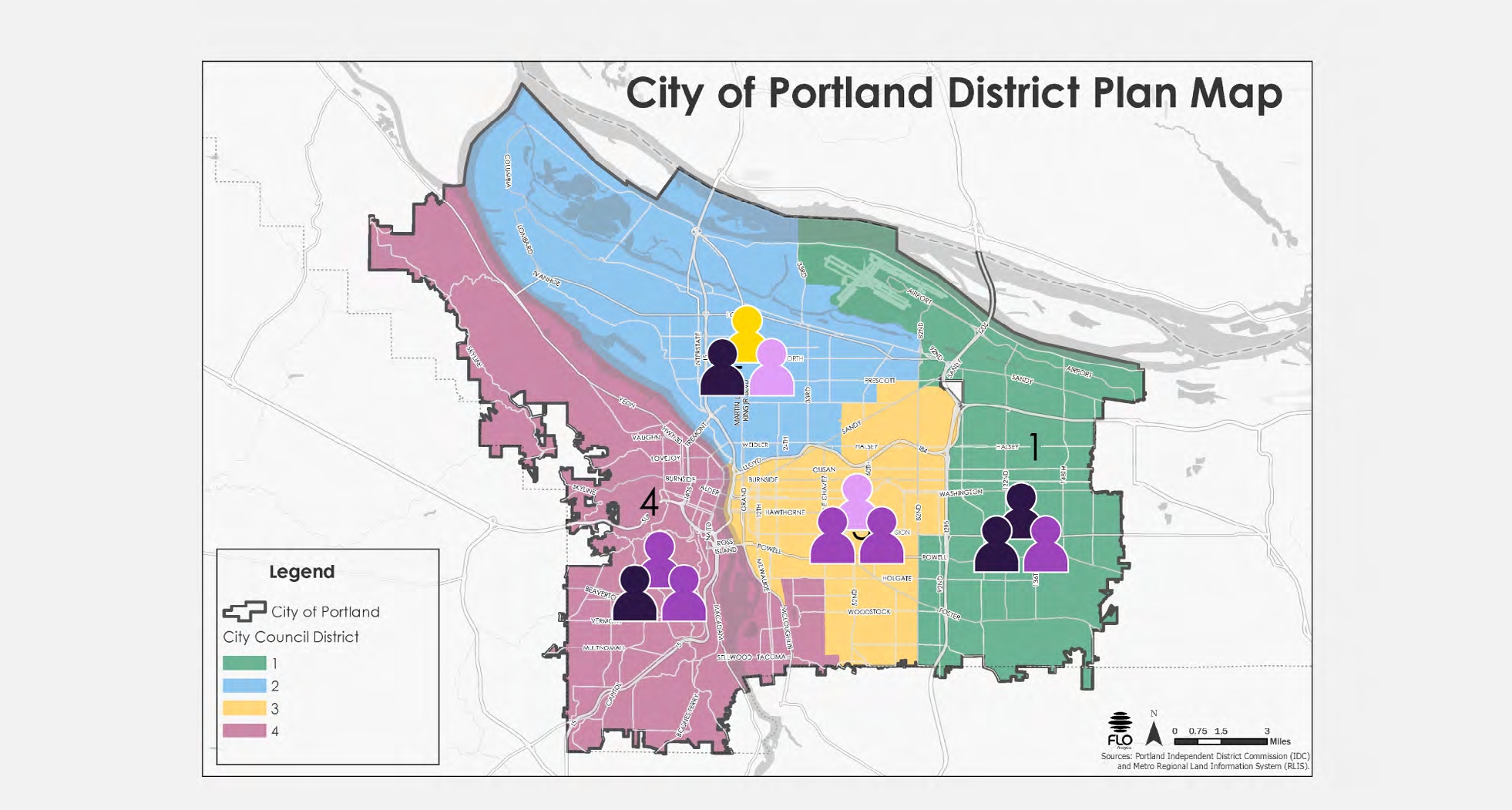
Process notes
- Alternate voting methods were documented as part of the charter reform conversation at the first community engagement session in summer 2021, as well as through survey responses. Multi-winner elections were documented in community engagement sessions starting in January 2022.
- The Commission held policy discussions with 34 community-based groups (religious groups, racial and ethnic groups, labor organizations, student groups, and other interest groups), and emerging themes from those conversations included 1) the need for more representation, 2) preference for multi-member districts, and 3) preference for a voting method that allows historically underrepresented communities to be represented.
- Once the Commission turned the engagement session findings into a set of recommendations, it held a public hearing and comment period. There were documented questions and concerns about multimember districts and ranked choice voting, but a preponderance of commenters voiced their unequivocal support for the full package of reforms.
- The Commission also conducted public opinion research, with the firm FM3 Research. Key findings from the survey included that majorities of voters supported changing the form of government, with four in five Portland voters (80%) believing the then-council structure did not serve the city well, and even larger majorities wanting geographic districts with multiple council members and ranked choice voting.
- RepresentUs and Power for Communities of Color also commissioned a survey with research firm GBAO Strategies, which found that city governance and electoral reform ballot proposals were broadly popular in Portland, and garnered strong majority support.
Conclusion
As RCV becomes more popular, more advocates and policymakers will face the question of how to implement RCV in their existing multi-winner elections, and whether to convert any single-winner elections into multi-winner ones.
These recommendations chart a path forward for advocates, elected officials, charter commission members, and others. Our recommendations would not only improve representation, but would also help ensure successful implementation of RCV and insulate against challenges or pushback from voters.
When implemented thoughtfully, multi-winner RCV can deliver better representation, minimize the impact of gerrymandering, and provide useful information to voters to make the ballot more approachable.


